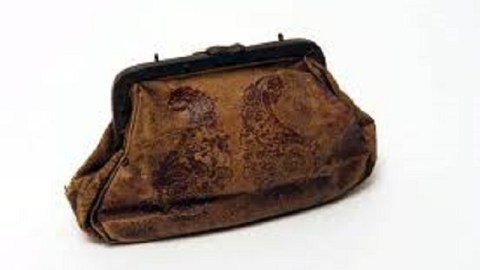Making Art (and History) Personal

Last Sunday, June 23rd, I gave a lecture at the Sanderson Museum in Chadds Ford, Pennsylvania, titled “Art Made Personal: Chris Sanderson and The Wyeth Family.” Below is a summary of my remarks. Throughout, I refer to Christian Sanderson and Andrew Wyeth as “Chris” and “Andy,” respectively, in the spirit of personal connection the museum encourages. Unless noted otherwise, all references are to artifacts or artworks in the Sanderson Museum collection:
When I visited the Sanderson Museum, the one item that caught my imagination most powerfully was the tiny change purse (shown above) once owned by Jenny Wade, a 20-year-old woman shot and killed while baking bread in her sister’s kitchen for Union troops during the Battle of Gettysburg. When Chris visited Gettysburg on the 50th anniversary of the battle, he met Jenny’s sister and struck up a friendship. Knowing that Chris would cherish the artifact, Jenny’s sister later mailed the purse, which was in Jenny’s pocket the moment she died, to Chris, who placed it in his collection along with other countless mementos of the Civil War and other parts of American history. Chris’ relationship with that little purse exemplifies his relationship with history itself—physical, personal, and powerfully alive.
As an educator myself, I’m fascinated with how Chris took his hands-on educational experience as a teacher and principal and employed educational theories in his approach to history that wouldn’t be articulated by theorists until decades later. The trend in the teaching of history in the last 40 years has been that of Howard Zinn’s A People’s History of the United States and Ken Burns’ documentaries on The Civil War and others. But Chris was Ken Burns before there was even a PBS, engaging people with the power of the personal—letters, private photographs, family stories—over the conventional history of presidents and generals.
Chris intuited the ideas of Harvard University’s Howard Gardner regarding multiple intelligences (that some people think in pictures or music rather than in words in a book) and found ways to reach every person, ranging from a fragment of cloth from a downed zeppelin to the music he’d play at square dances. Likewise, Chris practiced the educational theory of constructivism (that we learn by constructing pieces of old knowledge into new knowledge) through his collection. For example, when we look at Jenny Wade’s purse and hear the basic facts of her story, we automatically imagine what a 20-year-old woman would look like, how she would be dressed in 1863, how the baking bread would smell, maybe even how that bread would taste—all elements within our own imagination that make the names and dates of history come alive and live on in our memory. Chris knew that learning was memory, but he also realized that memory was imagination, and that’s where the Wyeths’ come into the story.
Exact contemporaries both born in 1882, Chris and N.C. Wyeth became fast friends. N.C. would present Chris’ mother with his latest illustrated book each Christmas. The Sandersons and Wyeths spent many holidays together, continually sharing ideas about life, love, history, and art. When Chris ran into financial difficulties, N.C. helped him out, a tradition that Andy continued after his father’s death in 1945. The Wyeths knew that Chris’ work was too valuable to let it fail. But even before N.C.’s passing, Chris served as a teacher and father figure to young Andy. In 1937, 20-year-old Andy and 55-year-old Chris collaborated on a Map of Historical Chester County. More than just cartography, their map mingled people with the landscape. Although George Washington, William Penn, and “Mad” Anthony Wayne appear on the map’s borders, less well-known figures such as “The Fighting Quaker” Major General Smedley D. Butler, novelist Joseph Hergesheimer (who wrote about decadence of the rich before even F. Scott Fitzgerald did), and Norwegian violinist Ole Bull (who tried to start a Norwegian colony in Pennsylvania) appear. Unconventional historical figures such as baseball Hall of Famer Herb Pennock, Buffalo Bill Cody, and a representative Chester County Farmer illustrate how Chris never set boundaries when it came to history—anything involving people living their lives was precious to him. When Andy painted a portrait of Chris that same year, he placed a copy of their map in his hands and set in the background a fantasy landscape of all the places and things Chris held dear.
Chris taught the Wyeths how to share the same personalized historical perspective he enjoyed. Most holidays photos of the Wyeth family were actually taken by Chris, as they outsourced the documentation of their lives to him as he showed them the value of everyday history. Although we don’t think of Andy as a history painter, under Chris’ influence he painted historical places such as Independence Hall and Elfreth’s Alley, the oldest residential street in America. From that sense of conventional history, Andy soon developed a Sanderson-esque eye for more “common” history: a drawing of Chris playing fiddle at a square dance or a pastel (perhaps the only pastel Andy ever did) of his African-American friend Adam Johnson chopping wood. Without Andy’s paintings of the Chadds Ford African-American community of the 20th century, we might have no idea of how those people looked or lived—a perfect example of how Chris’ gift for preserving history rubbed off on the Wyeths. In this age of e-mail, e-cards, and e-vites, we may be greener, but we’re poorer for losing that powerful physical connection that items such as the Wyeths’ hand drawn and hand signed Christmas cards to Chris still convey.
Chris’ personalized historical perspective seeped into the Wyeths’ artistic imaginations, especially that of Andy, as they layered personal, public, and mythic history into one. For example, in N.C.’s In a Dream I Meet General Washington (at The Brandywine River Museum), painted in 1930 after N.C. nearly fell to his death from a scaffold while working on a mural of Washington, N.C. paints himself literally talking with the past in the person of Washington. But as N.C.’s present speaks with the past, he inserts a vision of the future into the lower left corner—a portrait of 12-year-old Andy sketching away. In his final years, Andy painted a similarly sized painting simply titled Me (also at The Brandywine River Museum) in which he places himself in that same lower left corner as an old man, still making art but now beside a river flowing towards a local mill. For Andy, the truest self-portrait, the truest “me,” was the river of time flowing through all his work, back to his days with N.C. and Chris as well as forward to those who would one day view his art and remember.
All Andy’s art linked to the Olsons in Cushing, Maine, and the Kuerners in Chadds Ford exemplifies this personalized view of history in how he turned simple, everyday people into mythic figures that flood the imagination with deep significance. Whereas Howard Zinn wrote a “people’s history,” Andy painted one. Perhaps Andy’s most powerful, multi-layered work of history is his 1951 tempera Trodden Weed (private collection). Recovering from a serious illness that involved the removal of part of his lung, Andy sensed his own mortality powerfully at that time. In Trodden Weed, Andy paints himself from the waist down walking across a hill in antique French Chevalier boots and stepping on a weed. But they’re not just any boots—they’re boots once owned by his father, who inherited them from his teacher, Howard Pyle. And it’s not just any hill, it’s Kuerner’s Hill, where he had walked his entire life and painted so often. Add to all that personal historical weight the biblical allusion to the First Epistle of Peter (1 Peter 1:24) reminding us “For all flesh is as grass, and all the glory of man as the flower of grass. The grass withereth, and the flower thereof falleth away.”
With layer upon layer of history and associations ranging from personal to biblical, Trodden Weed reminds us that history is literally always beneath our feet. All we need to do is reach down and grab it, like the wood shavings from preacher Billy Sunday’s meeting, the sand from when the Panama Canal was being built, and even the vial of melted snow from the South Pole that can be found in Chris’ collection. Why do we go to museums, especially in this time of virtual reality? To see the thing itself, to share the presence. As one of my favorite philosophers of art, my 7-year-old son Alex, said in reply to his teacher’s question of whether you can touch the art at a museum, “You can’t touch the paintings with your hand, but you can touch it with your heart.” Or as Andy put it: “I think one’s art goes as far and as deep as one’s love goes. I see no reason for painting but that. If I have anything to offer, it is my emotional contact with the place where I live and the people I do.” Chris and Andy both knew deeply that preserving physical artifacts and creating physical artworks that save people and places from the ravages of time are ultimately acts of love.
Another artifact from the Sanderson Museum that stuck in my head as I put together this talk was the fragment of the bandage used to stop Abraham Lincoln’s mortal head wound. Thinking of that artifact, I realized that history is always bleeding away from us. Chris’ approach to history tried to stop that bleeding, just as Andy’s art stops time from bleeding away and allows us to remember. Most importantly, the works of both men remind us of the value of remembering. History and art aren’t things that happen in no place to no one—both, at their best and most meaningful, are always personal.





